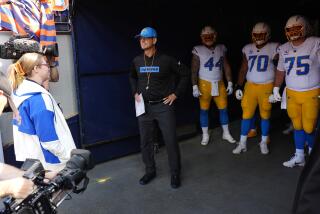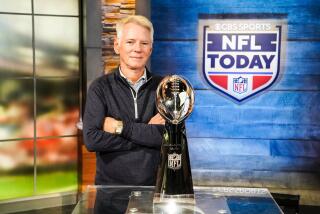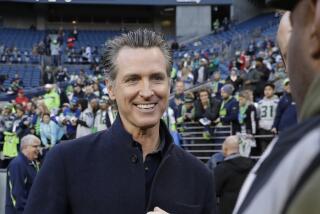NFL needs to get out ahead of concussion problem
From Indianapolis -- The rooms were separated by 40 steps. It could have been 40 miles. It might, one day, be 40 lifetimes.
In a hotel ballroom here Friday, in his annual Super Bowl address, NFL Commissioner Roger Goodell spoke glowingly about concussion treatment goals.
In a meeting room around the corner, an hour later, officials from a brain studies center talked somberly about concussion treatment realities.
In the ballroom, there were hundreds of media members.
In the meeting room, there were seven.
“It’s not a sexy topic,” said Chris Nowinski, Sports Legacy Institute chief executive. “Nobody wants to think about this.”
In the ballroom, there was a sparkling stage, glittering lights, the commissioner of a violent sport smoothly selling the masses on his commitment to safety.
In the meeting room, somebody hastily hauled away an NFL lectern before the brain people could begin speaking behind it. Once they began, their words were sometimes drowned out by nearby dance music.
“We’re talking about needing a dramatic culture change,” Nowinski said. “We’re talking about redefining manhood.”
Forty small steps, two vastly different agendas.
The NFL is wrestling with the notion that its best asset is also its deadliest. Realizing that the highlight head shots that popularize the brand might also be killing the players, the league is trying to figure out how to convince its teams to forgo victories to save lives.
The Sports Legacy Institute, in conjunction with Boston University, wants to take the politics out of all this by simply showing that concussions kill — and they have the brains to prove it.
So far, with financial help from the NFL, they have collected more than 100 donated brains from deceased athletes and soldiers. They have tested 80 of those and diagnosed 60 with Chronic Traumatic Encephalopathy, a neurological disease linked to concussions and repeated head trauma.
The brains of Dave Duerson and Andre Waters, two former star players who committed suicide, are among those diagnosed with CTE. There are countless other stories of aging players suffering dementia from too many hits to the head.
“Making people understand is like, many years ago, making people understand the connection between smoking and lung cancer,” Nowinski said. “One thing doesn’t come immediately after the other. Players don’t walk off the field and immediately get dementia. Everybody looks fine. Nobody has any idea.”
In the ballroom, hundreds of media members heard Goodell talk about the league’s effort to protect its players, which includes increased penalties for head shots and the utilization of an independent trainer to identify likely concussions when they happen.
In the meeting room, seven media members heard the brain people talk about how that’s just not enough.
This was the season when Cleveland Browns quarterback Colt McCoy was leveled by a devastating blow to the head from the Pittsburgh Steelers’ James Harrison, suffering a concussion that was viewed by millions . . . yet he was not even examined for a concussion and was sent back into the game.
This was also the season when Kris Dielman, a San Diego Chargers guard, was knocked silly during a game against the New York Jets, yet remained in the game, and later suffered a seizure on the flight home.
In the ballroom, Goodell said, “We think we have the finest doctors in the world taking care of our players.”
In the meeting room, Nowinski said, “I have suspicions about longtime team doctors looking the other way.”
Those suspicions are shared by many. The answer to this dilemma would be simple. Instead of installing an independent trainer to look for concussions — a move the NFL made in response to the McCoy incident — why not require that all team doctors be independent?
Team doctors in the NFL often pay the teams for the right to treat their players. The teams get free medical care while the physicians get to advertise themselves as Dr. Jock. It works for everyone — except for the players, who sometimes must wonder whether they are being forced back into a game at great physical risk for the sake of the team.
“The way it works now, we can’t expect 100% honesty during a game until the team doctors are completely independent,” Nowinski said. “This is still a game for money, still a game for entertainment, and doctors might not want to tag a guy with a concussion diagnosis because of the economic consequences.”
The issue is so distressing that SLI used its news conference Friday to issue a proposal for a “hit count” for youth football leagues. The SLI is hoping to convince organizers of this country’s three million youth football players to require the removal of players from games after a certain number of hits, like a pitch count is used in youth baseball.
Youth tackle football can be so violent, so early, even Indianapolis Colts center Jeff Saturday, who showed his support by attending Friday’s news conference, refused to let his son play until he was 11.
“Football is so fun to watch, so fun to play, yet we ethically have to address the danger to children,” Nowinski said.
The sign outside the hotel ballroom read, “Large Press Conference.”
The sign outside the meeting room read, “Small Press Conference.”
Should be the other way around.
twitter.com/billplaschke
More to Read
Go beyond the scoreboard
Get the latest on L.A.'s teams in the daily Sports Report newsletter.
You may occasionally receive promotional content from the Los Angeles Times.











